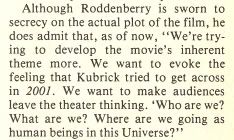Absolutely correct. Jeffries' design incorporated elements which made sense, and very few gave us the appearance of being "just for style." The 1701 didn't have "fins" but it did have a number of heat-management details, particularly on the engines, which make great technical sense (although to be practical, with currently-existing levels of technology, they'd really need to be much larger!)You can tell that from the pic in what you quoted? I really don't think there's enough detail there to tell.
They are ridged pipes attached to flat panels mounted on spacecraft components that presumably generate by far the greatest amount of waste heat when operating. What else could they be?
TGT
Some of you may have built your own computers, and maybe even used some cooling components with "heat pipe" type phase-change heat transfer elements. That's effectively what the 1701's engines had near the aft, and on the inboard face (what FJ eventually referred to as "the control reactor" and the "intercoolers"). He also had simple radiator panels on the pylons, near the aft on either side, and wrapping around the aftmost "exhaust cone" region (I've always assumed that for the series ship, the warp effect was generated in the little spheres at the aft end of the nacelles).
I LOVE those engines. They just make sense from an engineer's perspective. I never cared as much for the TMP-era engines (too "decorative" and not as functional in appearance). The early TNG-era nacelles were a little better (Probert's influence) but fell away into "cool blue and red LED lighting" pretty rapidly. The TOS nacelles are still, by far, my favorite.
What I've seen, so far, of the nacelles in this film (albeit I think we saw the Kelvin's nacelles, not the Enterprises, in the trailer!) seems more "style" and less "substance."
*****
On a slightly different point... I'm not 100% convinced that we're looking at a window on the bridge (though I'll admit it seems likely). There's just as much logic to assuming that we're looking at a holographic display as there is that it's a window. If it is, in fact, a "big freakin' window" that just illustrates, to me, that the set is being designed by folks who are thinking more about "how cool things look" than about "does this make sense?"
If it's a window... how do you change the magnification levels? Or the angle of viewing? Or the "signal processing?" In space travel terms, you're almost never REALLY close enough to see what you're nearby... even with the simple orbital space travel we do today. In interstellar-travel terms... a window really is useless, isn't it? And in real terms, space is generally really really dark... except when it's really, really bright. To have visually useful information, you need to process the information being brought in to better match the range of sensitivity of the human eye (or "vulcan eye?")
So a window may be nice for "casual viewing" purposes but for the operation of a space vessel... not so much.



